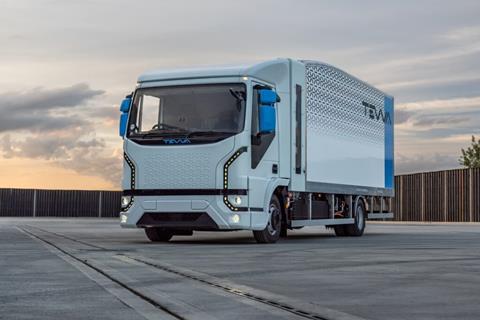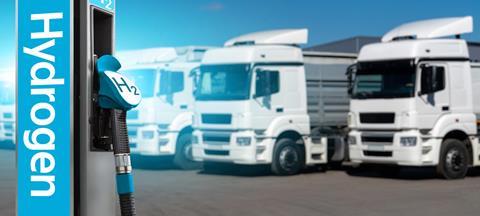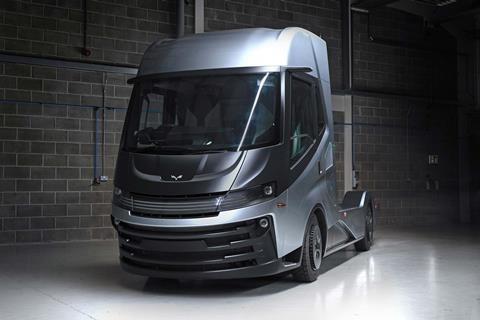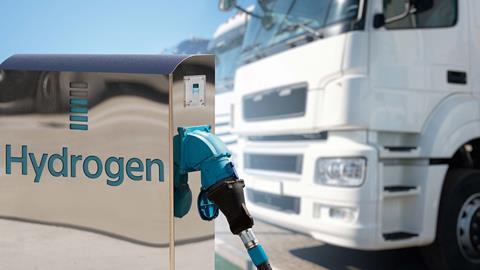What is the technology?
There are two types of hydrogen fuelled technologies, the first being fuel cell technology; this utilises hydrogen to generate electrical energy which is then used to run a battery electric vehicle (BEV) with a far smaller battery than a 100% battery powered BEV.
The second technology is internal combustion engines fuelled with hydrogen as a replacement for diesel.
Hydrogen fuel cells
Hydrogen fuel cell (HFC) vehicles store compressed or liquified hydrogen in large pressure cylinders or cryogenic tanks respectively. The hydrogen is fed into the fuel cell across a membrane which separates the electrons from the protons of the hydrogen. The protons pass through the membrane and the electrons go around the membrane, and the electrons and protons recombine with oxygen. This process generates an electrical current and also binds the hydrogen and oxygen together to produce water (H2O).

The electrical current generated provides a consistent power source which can be used in two different ways – firstly when power is needed by the vehicle the electricity generated by the fuel cells goes directly to the motors and any additional power required is delivered by the onboard battery. When the motors do not need all of the power from the fuel cell, some power is diverted off to charge the onboard battery.
Hydrogen internal combustion
Like a petrol or compressed natural gas (CNG) engine, a hydrogen engine uses spark plugs to ignite the hydrogen in a cylinder to create explosive power. It is also possible to utilise hydrogen in a compression ignition engine by using a small amount of diesel to create ignition under compression to ignite the hydrogen. This system is similar to the compression technology in LNG engines. Again, this technology produces water as a waste product but, unlike fuel cells, the combustion process produces NOx.
Environmental considerations
CO2 emissions
Pure hydrogen, specifically H2 (hydrogen in its most common state includes two molecules), there is no carbon in the fuel as there is with hydrocarbon-based fuels like diesel. Therefore, the CO2 emissions on a tank to wheel (TTW) basis are therefore zero.
Despite the UK government (and the EU) focusing on tailpipe emissions (TTW only) the upstream emissions of any fuels obviously cannot be ignored. The upstream emissions from hydrogen can be (and in fact are today) significant. For hydrogen to be of any value in decarbonisation, green hydrogen only must be considered for transport applications.
Tailpipe emissions
HFC vehicles do not have a tailpipe as they are effectively battery electric vehicles with a hydrogen system to generate electricity – so, zero tailpipe emissions.

However, hydrogen internal combustion engines (ICEs) do have tailpipes and while no CO2 is emitted, NOx is, which makes them due for ‘phasing out’ with other ICEs under the current legislation. NOx is both a toxin and a greenhouse gas. There are efforts to entirely eliminate the NOx with after-treatment systems, although current diesel after-treatment systems are unable to do this.
Vehicle cost
It is difficult to imagine that a HFC vehicle could ever cost less than a purely electric vehicle. While the battery is likely to be 60%-70% smaller, the additional cost for the fuel cell, the hydrogen tanks and the integration of these things will offset the saving for the smaller battery.
Fuel cost
Green hydrogen, on a per unit energy basis, costs around three times more than the renewable electricity that was used to create it (liquid green hydrogen will likely cost four times more). On one level this means it will cost three or four times as much as a BEV to operate and with a higher capital cost too. In these terms the total cost of ownership (TCO) does not stack up against a BEV let alone a diesel. However, hydrogen would not even be in the running if this TCO argument were the only thing at play.
Because a hydrogen truck can be filled in a similar time to a diesel, the increased uptime can be factored into the cost model. The range is also better so it is quite possible for some operations to be able to outcompete BEVs with the uptime and range in the equation.

However, hydrogen costs too much today to make it cost effective in most situations. It may become much cheaper at some point when we have excess renewable energy and an infrastructure of electrolysers and a distribution network.
Ultimately, if it takes longer for cheap hydrogen stations to emerge than for batteries to become energy dense enough and able to charge in 30 minutes, it may be too late for hydrogen to make an inroad in all but a handful of energy intense applications.
Infrastructure
Where hydrogen is used today in industrial applications it is interesting to note that it is manufactured in situ, i.e., it’s made where it’s used. This is because transporting hydrogen is problematic, there are losses due to leakage, there are safety concerns due to the wide combustible range of the product, it cannot easily be transported in pipelines (at least not the pipelines designed for much larger natural gas molecules).
Some hydrogen busses operate today and there are a handful of places where hydrogen can be dispensed in the UK. These are generally close to the electrolysers which produce the hydrogen.

Shipping by road tanker is an option but the volume problem and those of leakage and safety arise here too – it requires three tankers to move the energy equivalent of one tanker for natural or biogas, so the inefficiencies keep coming up.
Payload
Hydrogen is light but it still requires a battery, and the storage options are either heavy pressure vessels or cryogenic tanks in the case of liquid hydrogen. It will probably be lighter than pure electric vehicles but there will be a penalty compared with today’s diesels.
Hydrogen combustion technology is competitive on payload and very little compromise is seen compared to diesel.
Range
The advantage of fuel cell technology over batteries is that more energy can be stored on board a vehicle and therefore an improved range is possible. And range is the problem with BEVs that hydrogen promises to solve; but first the physical size of hydrogen storage on board needs to be addressed, especially for 6x2 artics. For vehicles that are not limited on chassis space it is quite feasible to carry a days-worth of fuel onboard.
What’s more, hydrogen refuelling, while not quite as straightforward as filling a diesel tank, can be done in a comparable timeframe negating the downtime necessary to recharge batteries.
Availability
Hydrogen is light (it is the lightest element of all) but it is not dense i.e., enough hydrogen for a day’s work can weigh very little compared with batteries and diesel, however, the space required for a days-worth of hydrogen can take up as much room as 2,000 litres of diesel. The weight benefit is also offset somewhat by the weight of the tanks required to store either compressed or liquified hydrogen. The UK 6x2 artic market poses a significant problem for hydrogen just as it does with batteries, in so much as it’s impossible to carry enough fuel for a day’s work in the chassis space between the back of the cab and the 2nd axle.
Summary
Hydrogen appears on the surface to solve some of the decarbonisation problems with heavy trucks - there are zero tailpipe emissions, it’s light and it’s quick to fuel; however, it is expensive, its volume is significant, there is limited production, limited distribution, and it’s an inefficient use of renewable energy.

However, hydrogen has the highest capital cost of all proposed alternative fuel solutions. Perhaps at some point in the future the cost issues will be overcome or bought in line - there are certainly operations running multiple shifts or timed deliveries where the uptime advantages could offset the additional running cost.
Some argue that hydrogen is a better final goal than electrification even with its inefficiencies; the argument goes - batteries are ultimately consumable and need excessive mining to produce, whereas hydrogen can be made indefinitely and cheaply using otherwise rejected renewable electricity. Others believe that pursuing hydrogen for transport will only delay more accessible and efficient electrification.











